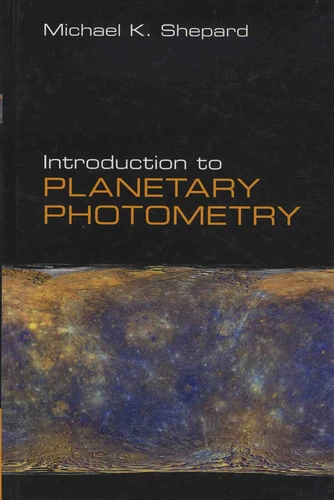Introduction to Planetary Photometry
Par :Formats :
- Paiement en ligne :
- Livraison à domicile ou en point Mondial Relay indisponible
- Retrait Click and Collect en magasin gratuit
- Réservation en ligne avec paiement en magasin :
- Indisponible pour réserver et payer en magasin
- Nombre de pages250
- PrésentationRelié
- FormatGrand Format
- Poids0.54 kg
- Dimensions15,7 cm × 23,3 cm × 1,5 cm
- ISBN978-1-107-13174-3
- EAN9781107131743
- Date de parution01/04/2017
- ÉditeurCambridge University Press
Résumé
Introducing planetary photometry as a quantitative remote sensing tool, this handbook demonstrates how reflected light can be measured and used to investigate our solar system. The author explains how data gathered from telescopes and spacecraft are processed and used to infer properties such as the size, shape, albedo, and composition of celestial objects including planets, moons, asteroids, and comets.
Beginning with an overview of the history and background theory of photometry, later chapters delve into the physical principles behind commonly used photometric models and the mechanics of observation, data reduction, and analysis. Real-world examples, problems, and case studies are included, all at an introductory level suitable for new graduate students, planetary scientists, amateur astronomers and researchers looking for an overview of this field.
Beginning with an overview of the history and background theory of photometry, later chapters delve into the physical principles behind commonly used photometric models and the mechanics of observation, data reduction, and analysis. Real-world examples, problems, and case studies are included, all at an introductory level suitable for new graduate students, planetary scientists, amateur astronomers and researchers looking for an overview of this field.
Introducing planetary photometry as a quantitative remote sensing tool, this handbook demonstrates how reflected light can be measured and used to investigate our solar system. The author explains how data gathered from telescopes and spacecraft are processed and used to infer properties such as the size, shape, albedo, and composition of celestial objects including planets, moons, asteroids, and comets.
Beginning with an overview of the history and background theory of photometry, later chapters delve into the physical principles behind commonly used photometric models and the mechanics of observation, data reduction, and analysis. Real-world examples, problems, and case studies are included, all at an introductory level suitable for new graduate students, planetary scientists, amateur astronomers and researchers looking for an overview of this field.
Beginning with an overview of the history and background theory of photometry, later chapters delve into the physical principles behind commonly used photometric models and the mechanics of observation, data reduction, and analysis. Real-world examples, problems, and case studies are included, all at an introductory level suitable for new graduate students, planetary scientists, amateur astronomers and researchers looking for an overview of this field.

